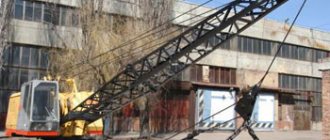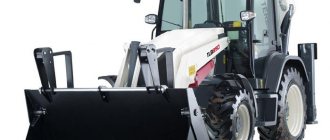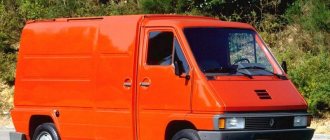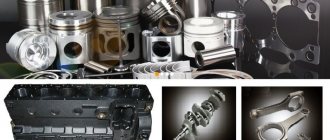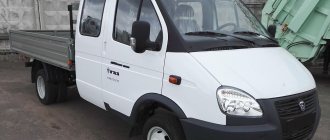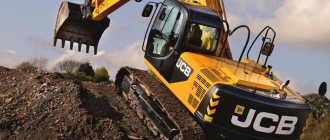The 4HG1 engine is positioned, that is, a power unit capable of running about 1,000,000 km before overhaul. The engine was created primarily for HQR71 series trucks with a gross weight of 8 tons. In addition, it is used in Bogdan buses and Isuzu Elf light-duty trucks.
ICE 4HG1
Isuzu designers used original solutions in the 4HG1 engine to provide torque of 153 Nm and power of 121 hp:
- in-line engine diagram with timing gear drive;
- overhead single camshaft controlling 4 intake and 4 exhaust valves via rocker arms.
Cylinder head 4HG1
Trucks are produced in Japan and at the Ulyanovsk Automobile Plant, part of the Sollers association. Unlike passenger cars of classes A - D, the owner is not faced with the task of increasing power after purchase. Much more important is the payback period and, accordingly, the resource and operating budget.
For the 4HG1 diesel engine, the modernization of its design made it possible to provide a service life of 1 million km. Initially, the management of the Japanese manufacturer provided for even such little things as the cost of the gear drive:
- if the timing gear, oil pump and cylinder liner wear out, these parts do not have to be replaced entirely;
- The manufacturer Isuzu produces bushings in several repair sizes that can be pressed in and bored on a machine.
Diesel injection pump 4HG1
This ensures the preservation of the operating parameters of the internal combustion engine and reduces maintenance costs.
You can study the technical characteristics of 4HG1 in the table below:
| Manufacturer | Isuzu |
| Engine brand | 4HG1 |
| Years of production | 2008 – … |
| Volume | 4570 cm3 (4.6 l) |
| Power | 83 kW (121 hp) |
| Torque moment | 322 Nm (at 4200 rpm) |
| Weight | 377 kg |
| Compression ratio | 19 |
| Nutrition | injector |
| Motor type | in-line diesel |
| Ignition | DIS-2 |
| Number of cylinders | 4 |
| Location of the first cylinder | TVE |
| Number of valves on each cylinder | 2 |
| Cylinder head material | cast iron |
| Intake manifold | duralumin |
| An exhaust manifold | cast iron |
| Camshaft | carbon steel, SOHC design |
| Cylinder block material | cast iron |
| Cylinder diameter | 115 mm |
| Pistons | cast aluminum |
| Crankshaft | steel 5 support, 8 counterweights |
| Piston stroke | 110 mm |
| Fuel | AI-92 |
| Environmental standards | Euro 2 |
| Fuel consumption | highway – 22.5 l/100 km combined cycle 24.3 l/100 km city – 26.5 l/100 km |
| Oil consumption | 0.6 l/1000 km |
| What kind of oil to pour into the engine by viscosity | 5W30, 5W40, 0W30, 0W40 |
| Which engine oil is best by manufacturer | Liqui Moly, LukOil, Rosneft |
| Oil for 4HG1 according to composition | synthetic in winter, semi-synthetic in summer |
| Engine oil volume | 10 l when replacing filter |
| Operating temperature | 95° |
| ICE resource | declared 450,000 km actual 1,000,000 km |
| Adjustment of valves | hydraulic compensators |
| Cooling system | forced, antifreeze |
| Coolant volume | 18 l |
| water pump | built-in |
| Spark plugs for 4HG1 | NGK 32A6607200 |
| Spark plug gap | 1.1 mm |
| Timing drive | gear |
| Cylinder operating order | 1-3-4-2 |
| Air filter | VIC A-522V, Top Fils A-519/A-510 |
| Oil filter | SK815, Asakashi C518J, Xauto LC711, Union C7111 |
| Flywheel | 8-97209-844-3 350 mm, 8 holes |
| Flywheel mounting bolts | M12x1.25 mm, length 26 mm |
| Valve stem seals | manufacturer Goetze, inlet light, exhaust dark |
| Compression | from 13 bar, difference in adjacent cylinders maximum 1 bar |
| XX speed | 750 – 800 min-1 |
| Tightening force of threaded connections | spark plug – 25 Nm, flywheel – 78 Nm + 90° – 120° clutch bolt – 96 Nm bearing cap – 98 Nm, 132 Nm + 30° – 60° (main) and 83 Nm (connecting rod) cylinder head – three stages 98 Nm, 147 Nm + 30° – 60° |
The user manual contains a description of the design and step-by-step steps for servicing the diesel engine.
Engine characteristics
The 4hg1 engine has 4 cylinders arranged in a row. If the motor elements wear out, there is no need to immediately buy a new one. Isuzu produces individual spare parts, changing them will extend the life of the engine.
The engine camshaft is made of carbon steel. Multi-row plunger pump for Isuzu 4hg1 with timer. The piston pin is offset which helps reduce noise. The special shape of the piston is provided for rapid heat dissipation.
In 4hg1 engines, the reduction pipe is made of an abrasive material with a rubber admixture. This composition helps reduce noise. The outlet manifold is made of cast iron.
The engine does not have a complex design.
More detailed technical specifications are given in the table below.
| Engine capacity, cubic meters cm | 4334-4570 |
| Maximum power, l. With. | 133 |
| Motor type | 4-cylinder, in-line |
| Nutrition | diesel, injection pump |
| Motor material | steel, duralumin, cast iron |
| Pistons | aluminum cast |
| Lubricant | 5W30, 5W40, 0W30, 0W40 |
| Oil consumption during replacement, l | 10 |
| Operating temperature, degrees Celsius | 95 |
| Adjustment of valves | hydraulic compensators |
| Compression, bar | from 22 |
| Antifreeze, volume, l | 18 |
| Spark plug | NGK 32A6607200 |
| Fuel consumption, l/100 km | 22,5/24,3/26,5 |
| Oil consumption, l/1000 km | 0,6 |
| Layout | SOHC, overhead camshaft |
| Cylinder diameter, mm | 115 |
| Start-stop system | No |
List of internal combustion engine modifications
The naturally-aspirated diesel engine 4HG1 from Isuzu has a Turbo modification 4HG1-T with the following characteristics:
- power – 121 hp;
- torque - 322 Nm;
- compression ratio – 19;
- environmental standards – Euro-2;
- consumption in the urban cycle is about 20 liters.
Modification 4HG1-T
The diesel engine is equipped with a Turbocharger 704136-0003 turbocharger with a GT3076R kit and an intercooler.
Pros of the 4hg1 engine
The 4hg1 motor has a number of advantages:
- economical consumption of lubricant and diesel fuel;
- high maintainability;
- the presence of hydraulic pushers that regulate the thermal clearances of the valves;
- valve protection is ensured by gear transmission.
Timing gear
You will have to visit the service center for maintenance no more often than after 60,000 km.
Review of faults and methods for repairing them
Thanks to the gear drive, the 4HG1 motor never bends the valve, but has some characteristic malfunctions:
| Heavy oil leak | 1) depressurization of the neck plug 2) destruction of the cylinder head cover seal 3) wear of the fuel pump gasket | 1) replacing the plug 2) replacing the valve cover gasket 3) replacing the fuel injection pump gasket |
| Smooth but unreasonable decrease in lubrication level | 1) loosening the camshaft plug 2) the plug thread is broken 3) crankcase ventilation is clogged 4) development of the rear oil seal 5) weakening the oil filter | 1) pulling bolts 2) replacing the plug 3) cleaning the crankcase ventilation 4) replacing the oil seal 5) replacing the gasket and tightening the filter with a special tool |
| Noise inside the timing belt | 1) leakage in hydraulic compensators 2) wear of the roller or rocker arm 3) rod deformation 4) low lubrication level | 1) replacement of hydraulic pushers 2) replacing the roller and rocker arm 3) replacement of rods 4) topping up engine oil |
Repair 4HG1
The power drive was originally created for harsh operating conditions, therefore, with a service life of one million hours, it is highly reliable and does not cause problems for the user.
Disadvantages of the 4hg1 engine
Like any technical equipment, the 4hg1 internal combustion engine also has disadvantages.
- After 80,000 km, the hydraulic pushers begin to make ringing sounds. This is a signal that they need to be changed.
- Sensitivity to fuel. Diesel engines run on diesel fuel. If the sulfur and paraffin in its composition exceed the permissible values, starting the engine will be difficult, especially in cold periods. The resource of the ShPG will also decrease.
Camshaft camshaft gear
How it works
The operation of modern turbochargers is reduced to elementary circuits. The aggregate turbine is integrated into the engine system, and the compressor is installed into a separately located intake tract. During the operation of the system, exhaust gases move into the turbine, constantly hitting the wheel blades.
Thus, part of the energy is transferred to the wheel, causing it to rotate. Torque is transmitted to the compressor wheels from the turbine. During the rotation process, air moves to the peripheral part. Accordingly, the pressure increases and the air moves into a special intake manifold.
The ISUZU NQr71 turbocharger requires minimal maintenance. To ensure long-term operation, it is necessary to change the oil and oil filter on time. If the engine is still running on old oil, this can be extremely dangerous for the turbocharger. Even a slight decrease in the quality of the lubricant material under significant loads leads to destruction of the unit.
In addition, it is recommended to occasionally clean the turbine components from accumulated carbon deposits. In this case, the system is analyzed. It should be noted that this work must be carried out using equipment and special tools.
Engine oil 4hg1
It is recommended to fill 4hg1 power units with synthetic lubricant. In summer, it is possible to use semi-synthetics. The frequency of lubricant changes depends on:
- machine operating conditions;
- motor type;
- age of the vehicle.
If the car is regularly overloaded, frequently idle, short trips in the winter season, or the power unit is running at idle speed, the oil must be changed every 8 thousand km. with a frequency of 2 times a year.
As for the Isuzu Elf 4hg1 engine type, the lubricant needs to be changed more often on diesel engines. Gasoline engines clog the oil less.
It is also worth taking into account the degree of wear of the engine itself. The longer the unit serves, the faster the lubricant will lose its properties.
Motor oil has its own viscosity. For the 4hg1 engine, the manufacturer recommends using lubricant with viscosity values 5W30, 5W40, 0W30, 0W40. Brand oils are suitable.
- Liqui Moly
- LukOil
- Rosneft
- Kixx D1 RV 5W-30
On vehicles under warranty, the dealer changes the filter and oil once a year.
Isuzu Elf: reliable Japanese trucks
The Isuzu Elf is a compact medium-duty truck whose production began in 1959. Outside Japan, this model is also known under the symbol N (N-series). Photos of the first generation Isuzu Elf have been preserved:
At first, the model range was represented only by a two-ton truck with a 1.5 liter gasoline engine, then the Isuzu Elf 150 with a load capacity of 1500 kg, the Isuzu Elf 250 with a load capacity of 2500 kg, and the Isuzu Elf 350, capable of carrying up to 3500 kg of payload, appeared.
Isuzu Elf was produced not only in Japan. These trucks are assembled in Russia by the Russian-Japanese JV SOLLERS-ISUZU CJSC, in Latin American countries at GM factories under the Chevrolet brand with the obligatory Isuzu Technology nameplate, and in Malaysia they are known under the name HICOM Perkasa.
The main competitors of the Isuzu Elf are trucks from other Japanese automakers - Mitsubishi Fuso Canter, Nissan Atlas, Toyota Dyna and Hino Dutro.
Isuzu Elf models
Currently, the model range of Isuzu Elf and N-series trucks includes 8 modifications, differing in cab dimensions, chassis length and number of drive wheels:
- two models with a single cab (Standard Cab): NLR with a gross weight of 4.1 tons, as well as NMR with a total weight of up to 5.5 tons:
- two modifications with a wide cab (Wide Cab): 7-ton NPR and 8-ton NQR with increased chassis length:
- all-wheel drive model with a wide cab (Wide Cab 4WD): NPS gross weight 6 tons:
All-wheel drive version of Isuzu Elf 4WD
- as well as three variants of the double cab (Crew Cab): NLR, NMR and NPR, the permissible gross weight of which is 3.3 tons, 5.5 tons and 6 tons, respectively:
Overall dimensions of Isuzu Elf trucks
The dimensions of Isuzu Elf trucks depend on the type of cab, chassis length and superstructure size.
- Dimensions of Isuzu NLR:
NLR - the most compact chassis option
- Dimensions of Isuzu NMR:
Overall dimensions of the NMR modification
- Dimensions of Isuzu NPR:
Overall dimensions of the NPR modification
Isuzu Elf: technical specifications
Technical characteristics of Isuzu NQR:
- permissible total weight - 8000 kg;
- cabin-chassis weight - 2500 kg;
- chassis load capacity - 5500 kg;
- gearbox type - manual, 5-speed;
- maximum speed - 120 km/h;
- fuel tank volume - 100 l;
- Fuel consumption rate is 16-17 l/100 km.
Technical characteristics of Isuzu NLR:
- permissible total weight - 3500 kg;
- cabin-chassis weight - 1850 kg;
- chassis load capacity - 1650 kg;
- gearbox type - mechanical, synchronized, 5-speed;
- fuel tank volume - 75 l.
Since Isuzu is one of the leaders in the diesel engine market, its products are distinguished by reliability, durability, efficiency, and the ability to develop high torque at low speeds. The engines that were equipped with the Isuzu Elf and Isuzu N-series before 2008 comply with Euro-2 standards, later models meet Euro-3 requirements. The NLR and NMR modifications are equipped with 4JJ1-TC and 4JB1-TC engines, and the NPR, NPS and NQR models are equipped with 4HG1-T and 4НК1-TCN engines.
Photos of engines 4HG1-T and 4JJ1-TC
Technical characteristics of Isuzu Elf engines:
4HG1-T
- working volume - 4,570 cubic meters. cm.
- maximum power - 121 hp at 3200 rpm
- maximum torque - 304 Nm at 1600 rpm
4NK1-TCN
- working volume - 5,193 cubic meters. cm.
- maximum power - 150 hp at 2600 rpm
- maximum torque - 404 Nm in the range of 1500-2600 rpm
4JB1-TC
- working volume - 2,771 cubic meters. cm.
- maximum power - 91 hp at 3400 rpm
- maximum torque - 196 Nm at 2000 rpm
Owner reviews
Owners of the 4hg1 motor speak positively about it.
“I bought a dream on credit – an Isuzu Elf. I chose the one with the 4hg1 engine, in-line mechanical fuel injection pump. I'm very pleased with the motor. During operation it has not yet broken down and does not run out of fuel. But even if it gets damaged, it can be repaired. Compared to newfangled electric ones, it wins 100%.
Rus85, Gorno-Altaisk.
“The engine has enough thrust in seventh gear. If loaded up to two tons, then the car drives as if empty. When overloaded, you feel long climbs, but as soon as you get on a flat road, you fly like a falcon. Doesn’t consume any oil at all.”
Gray, Blagoveshchensk.
“There are no complaints about the engine power. Over the several years that I have been using the Isuzu Elf, there have been no problems with the engine. It also started at -42 0 C. I can only note that the whole car vibrates while the engine is warming up. And it still smokes a lot. But after warming up everything becomes fine.”
Victor Konyshev, Krasnoyarsk.
List of car models in which it was installed
The 4HG1 motor powers the vehicles:
- Isuzu Elf – truck 2 – 3.5 tons;
- Isuzu NQR71 – 5.5 t 4x2 truck;
- Bogdan - city bus A092.02 and school bus A092S.
Isuzu NQR71
The above engine characteristics ensure long-term operation in harsh conditions.

